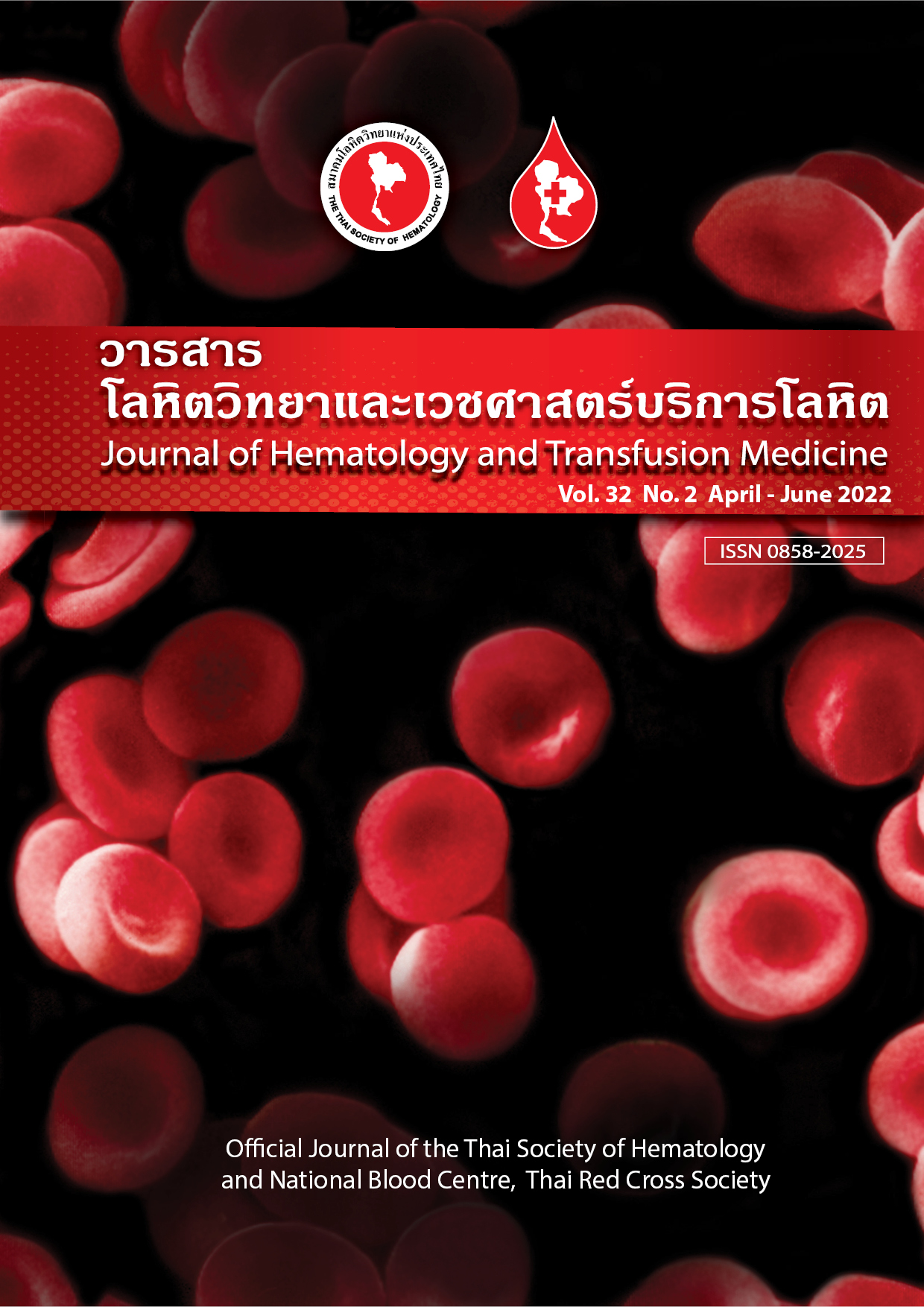Stop bleeding armband for venipuncture at antecubital fossa for blood donor
Keywords:
Bleeding prevention, Blood donations, Blood donation complications, Venipuncture, การหยุดเลือด, การเจาะหลอดเลือดดำ, การบริจาคโลหิต, การเกิดภาวะไม่พึงประสงค์จากการบริจาคโลหิตAbstract
Introduction: Blood donation is a common and important practice to provide blood for the saving of lives in medicine. Although several measures have been used to ensure the safety of both blood donors and recipients, there is still a small proportion of blood donors encountering unwanted post-donation complications, including, delayed bleeding, bruising, and hematomas. One of the causes for these unwanted complications is due to an incomplete or incorrect stop bleeding procedure. Objective: To reduce the possibility of complications, we designed equipment that produces an appropriate force to prevent bleeding of the venipuncture at the antecubital fossa from blood donations in the form of an adjustable armband. Materials and Methods: The armband was designed using the actual pressing force for stop bleeding of the venipuncture from a group of 63 experienced donors and evaluated the reliability with 424 practices in real practices. Results: The armband creates 1.6 N/cm2, which was measured from experienced donors. The armband is adjustable for different arm sizes, providing an appropriate generated force. Use of proper force can reduce the chances of adverse complications to 1.2% comparing to the prior study of the conventional stop bleeding method at 3.4%. Surprisingly, the armband can prevent all cases of delayed bleeding (0.8% found in the conventional stop bleeding method). In addition, the average deterioration of the armband was 1.6%, after 250 times of usage in real practice. Conclusion: The stop bleeding armband is effective in preventing bleeding of a venipuncture from the blood donation process, and it can reduce the number of occurred complications by generating an appropriate force.
บทคัดย่อ
บทนำ แม้ว่าการบริจาคเลือดจะมีหลายกระบวนการที่สำคัญเพื่อความปลอดภัยของผู้บริจาคโลหิตและผู้รับโลหิต แต่ก็ยังมีเหตุการณ์ไม่พึงประสงค์เกิดขึ้นกับผู้บริจาคโลหิต เช่น รอยฟกช้ำ หรือ เลือดไหลหยุดช้า ซึ่งหนึ่งในสาเหตุคือการหยุดเลือดที่ไม่สมบูรณ์ หรือไม่เหมาะสม วัตถุประสงค์ เพื่อลดการเกิดเหตุการณ์เหล่านี้ จึงมีการออกแบบสายรัดห้ามเลือดให้สายรัดสามารถปรับเปลี่ยนความยาวได้และสร้างแรงกดที่เหมาะสมในการกดห้ามเลือดในแผลที่เกิดจากการเจาะเลือด วัสดุและวิธีการ สายรัดถูกออกแบบให้สร้างแรงกดได้ใกล้เคียงกับแรงกดเฉลี่ยที่วัดมาจากผู้บริจาคเลือดจำนวน 63 คน จากนั้นสายรัดได้ทดสอบในการใช้งานจริงจำนวน 424 ครั้ง ผลการศึกษา สายรัดห้ามเลือดถูกออกแบบให้สามารถสร้างแรงกดที่ 1.6 N/cm2 (ค่าที่วัดจากผู้บริจาคเลือด) โดยสายรัดสามารถปรับเปลี่ยนความยาวเพื่อสร้างแรงกดให้คงที่และสอดคล้องกับผู้ใช้ที่มีขนาดเส้นรอบวงแขนแตกต่างกัน ทั้งนี้การหยุดเลือดด้วยแรงกดที่เหมาะสมสามารถลดการเกิดเหตุการณ์ที่ไม่พึงประสงค์ได้ ในสถานการณ์จริงที่ใช้สายรัดห้ามเลือด มีผู้บริจาคโลหิต 1.2% ที่เกิดรอยช้ำและไม่พบอาการที่เลือดไหลหยุดช้า ซึ่งพบ 3.4% และ 0.8% ตามลำดับในการศึกษาก่อนหน้า จากการทดสอบความทนทานของสายรัดหลังการใช้งาน 250 ครั้ง พบว่าสายรัดเกิดการยืดถาวร 1.6% ของความยาวสายรัด สรุป สายรัดห้ามเลือดที่ถูกออกแบบให้มีแรงกดที่เหมาะสมสามารถห้ามเลือดจากการบริจาคเลือดได้อย่างมีประสิทธิภาพ และลดการเกิดเหตุการณ์ไม่พึงประสงค์ได้
Downloads
References
World Health Organization. WHO guidelines on drawing blood : best practices in phlebotomy; 2010: p. 22.
Armstrong B. Blood collection. ISBT Sci Ser. 2008;3:123-36.
Goldman M, Land K, Robillard P, Wiersum-Osselton J. Development of standard definitions for surveillance of complications related to blood donation. Vox Sang. 2016;110:185-8.
Musikaphan S, Moudeaud D, Boorananayot S, Rujirojindakul P. Incidence of adverse reaction in whole blood donors obtained by telephone interviewing within 24 hours after donation. J Hematol Transfus Med. 2016;26:27-33.
Newman BH. Blood donor complications after whole-blood donation. Curr Opin Hematol. 2004;11:339-45.
Winters JL. Complications of donor apheresis. J Clin Apher. 2006;21:132-41.
Sorensen BS, Johnsen SP, Jorgensen J. Complications related to blood donation: a population-based study. Vox Sang. 2008;94:132-7.
Abhishekh B, Mayadevi S, Usha KC. Adverse reactions to blood donation. Innov J Med Heal Sci. 2013;3:158-60.
Nakajima K. Donor complications and donor care. ISBT Sci Ser. 2009;4:411-7.
Wiersum-Osselton JC, Marijt-Van der Kreek T, Brand A, Veldhuizen I, Van der Bom JG, De Kort W. Risk factors for complications in donors at first and repeat whole blood donation: a cohort study with assessment of the impact on donor return. Blood Transfus. 2014;12 (supple 1):s28-36.
Kamel H, Tomasulo P, Bravo M, Wiltbank T, Cusick R, James RC, et al. Blood donors and blood collection: delayed adverse reactions to blood donation. Transfusion. 2010;50:556-65.
Vuk T, Cipek V, Jukić I. Blood collection staff education in the prevention of venepuncture failures and donor adverse reactions: from inexperienced to skilful staff. Blood Transfus. 2015;13:338-9.
Eder AF, Notari EP 4th, Dodd RY. Do reactions after whole blood donation predict syncope on return donation? Transfusion. 2012;52:2570-6.
Downloads
Published
Issue
Section
License
Copyright (c) 2022 Journal of Hematology and Transfusion Medicine

This work is licensed under a Creative Commons Attribution-NonCommercial-NoDerivatives 4.0 International License.



